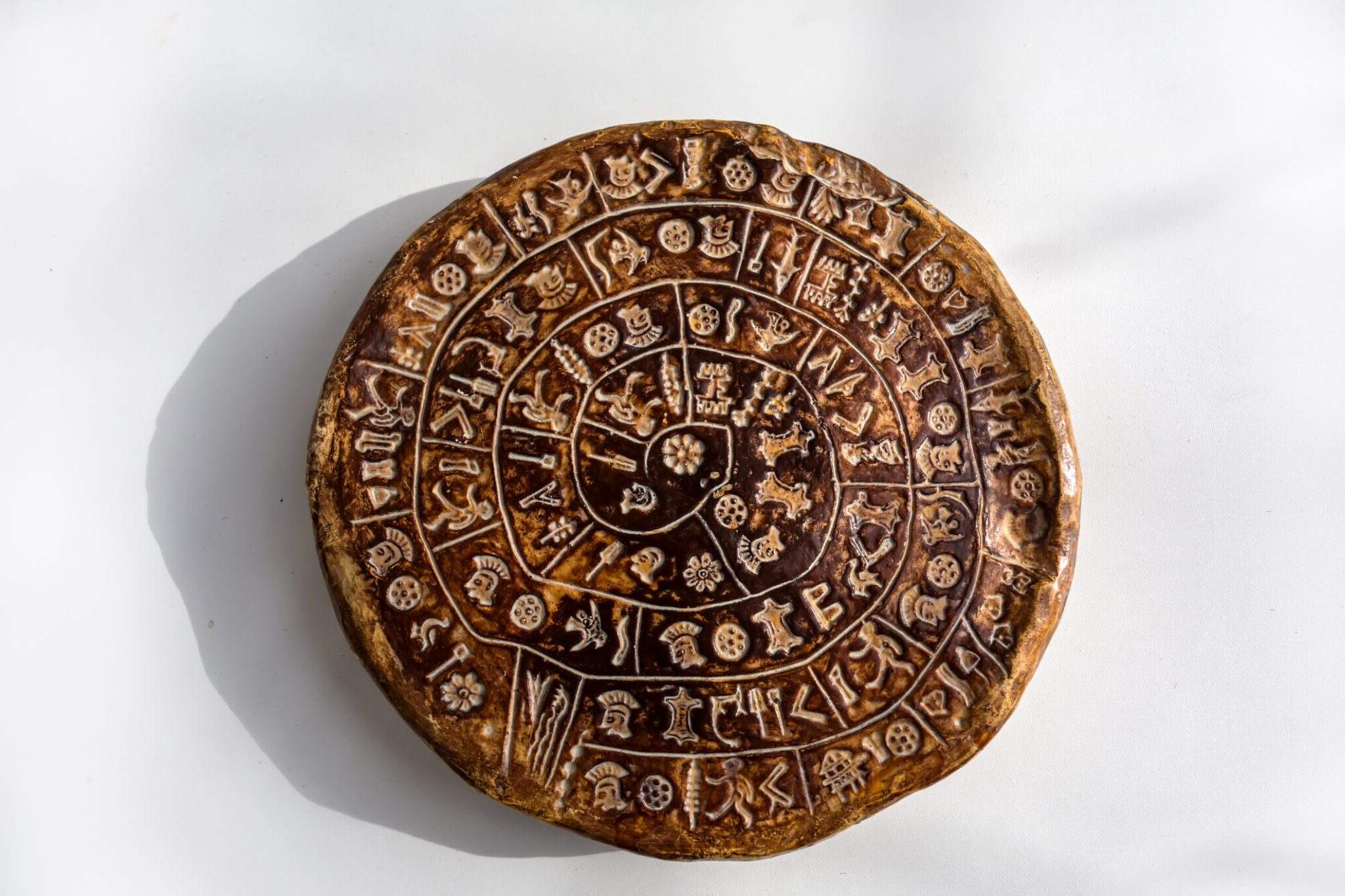
What is the Phaistos Disc? Imagine stumbling upon an ancient artifact that has puzzled scholars for over a century. That's the Phaistos Disc, a mysterious clay disc from the Minoan civilization, discovered in 1908 in Crete. Measuring about 16 cm in diameter, this disc features 241 unique symbols arranged in a spiral. Despite numerous attempts, its inscriptions remain undeciphered, sparking endless theories about its purpose. Some believe it’s a religious text, others think it’s a calendar or even a magical formula. Stored in the Heraklion Archaeological Museum, this enigmatic artifact continues to captivate both researchers and the public.
Key Takeaways:
- The Phaistos Disc, a 3700-year-old artifact from the Minoan civilization, remains a mysterious enigma with undeciphered symbols, sparking intense scholarly interest and public fascination.
- Despite numerous attempts, the unique inscriptions on the Phaistos Disc remain undeciphered, leading to ongoing debates about its authenticity and purpose, making it a star attraction in museums and a subject of intense scholarly interest.
Discovery and Characteristics of the Phaistos Disc
The Phaistos Disc is a mysterious artifact from the Minoan civilization. Its discovery and unique features have puzzled archaeologists and historians for over a century.
-
Discovery and Excavation: Found on July 3, 1908, by Italian archaeologist Luigi Pernier during excavations at the Minoan palace site of Phaistos in southern Crete.
-
Material and Size: Made of fired clay, it measures approximately 16 cm in diameter and 1.5 to 2.1 cm thick.
-
Unique Inscriptions: Features spirally arranged symbols on both sides, with a total of 241 unique characters. These symbols are unlike any known writing system and remain undeciphered.
-
Symbol Distribution: Characters are divided into sections, each containing two to seven characters separated by clear dashes. There are 30 sections on one side and 31 on the other.
-
Manufacturing Process: Symbols were stamped using pre-prepared stamps, indicating a high level of craftsmanship and organization.
Preservation and Display
Despite its age, the Phaistos Disc is remarkably well-preserved. Its current home and display methods ensure it remains a focal point for scholars and visitors alike.
-
Condition and Preservation: Despite being approximately 3700 years old, the disc is in excellent condition, with all marks perfectly visible and no cracks or cavities.
-
Intentional Burning: The disc was intentionally burned, unlike other Minoan clay tablets which were often burned accidentally during fires.
-
Storage and Display: Currently stored in the Heraklion Archaeological Museum in a separate glass case, displayed alongside other significant Minoan artifacts.
The Minoan Civilization and Writing Systems
The Phaistos Disc is a product of the Minoan civilization, known for its advanced culture and writing systems.
-
Minoan Civilization: Associated with the Minoan civilization, which flourished from around 1850 to 1100 BCE. The Minoans were known for their advanced civilization, including sophisticated palaces and trade networks.
-
Linear A and Linear B: The disc does not belong to either the Linear A or Linear B scripts used by the Minoans and Mycenaeans. Some scholars have attempted to link it to these scripts through comparative linguistics.
Attempts at Decipherment
Numerous scholars have tried to crack the code of the Phaistos Disc, leading to various theories and claims.
-
Decipherment Attempts: Despite numerous attempts, the Phaistos Disc remains undeciphered. Interpretations include religious texts, calendar records, and even magical formulas.
-
Dr. Gareth Owens' Claim: In 2018, Dr. Gareth Owens claimed to have deciphered 99% of the text on the disc using comparative linguistics and the vocal values of Linear B.
-
Collaboration with Professor John Coleman: Dr. Owens collaborated with Professor John Coleman from Oxford University in his decipherment efforts.
-
Minoan Language: Owens believes the disc is written in the Minoan script, recording the Minoan language. He argues this is the best sample of "Cretan hieroglyphics," though not a true hieroglyphic system like ancient Egypt's.
-
Sound Syllables: Owens has recorded the sound syllables from the disc, aiming to make the Minoan language more accessible. He emphasizes that Minoan is not a dead language and that many of its words are still used today in Crete.
Authenticity and Controversies
The authenticity of the Phaistos Disc has been a topic of debate, with some questioning its origins and purpose.
-
Unique Characters: The characters on the Phaistos Disc are unique and have not been found on any other Minoan artifacts, leading to speculation about its authenticity and potential forgery.
-
Authenticity Debate: Ongoing debate about the authenticity of the disc. Some scholars, like Jerome Eisenberg, suggest it might be a hoax created by Luigi Pernier to gain fame.
-
Arguments Against Authenticity: Arguments against authenticity include the lack of similar objects, the deliberate burning of the disc (unlike other Minoan clay tablets), and the irregular distribution of characters.
-
Similar Marks Found: Two objects bearing similar marks have been found: a labrys (double-bladed axe) from a cave in Arkalochori and a stone block in the Palace of Malia. This could strengthen the theory of the artifact's authenticity, but opinions are divided.
-
Thermoluminescence Analysis: A thermoluminescence analysis could determine when the disc was burned, potentially settling the authenticity debate. However, the authorities at the Heraklion Archaeological Museum have not agreed to such tests.
Interpretations and Scholarly Interest
The Phaistos Disc has inspired countless interpretations and remains a subject of intense scholarly interest.
-
Interpretations Galore: The disc has been interpreted in countless ways, including a hymn to Mother Earth, a call to war, a magic formula, and even erotic content. These interpretations reflect the complexity and mystery of the artifact.
-
Scholarly Interest: Despite the lack of clear understanding, the disc has garnered significant scholarly interest. It is often included in courses on ancient scripts and literacy, highlighting its importance in the field of archaeology and linguistics.
-
Public Fascination: The disc's uniqueness and enigmatic nature have captivated the public imagination. It is often displayed prominently in museums and has inspired numerous articles, books, and documentaries.
Museum Display and Public Engagement
The Phaistos Disc is a star attraction in museums, drawing visitors and sparking curiosity about ancient civilizations.
-
Museum Display: The Heraklion Archaeological Museum takes great pride in displaying the disc. The room where it is housed allows visitors to view it from all sides, emphasizing its significance in Minoan culture.
-
Pale Brownish-Gray Color: The disc has a pale brownish-gray color, quite different from the golden-brown, shimmering colors often depicted in photographs. This dull appearance contrasts with the vibrant colors found in other Minoan artifacts like vases and vessels.
-
Lack of Artistic Value: Unlike other Minoan artifacts like the Seal of Pylos or the Temple of Poseidon at Cape Sounion, the Phaistos Disc is not considered a work of art. Its functional purpose remains unclear, adding to its enigmatic nature.
Contextual and Historical Significance
Despite its mysterious nature, the Phaistos Disc holds immense contextual and historical significance.
-
Contextual Significance: Despite its lack of artistic value, the disc holds immense contextual significance. It represents a unique window into the writing systems and cultural practices of the Minoan civilization.
-
Historical Importance: The discovery of the disc has been pivotal in understanding the historical context of Crete during the Bronze Age. It highlights the advanced literacy and organizational skills of the Minoans.
Ongoing Research and Debates
Research on the Phaistos Disc continues, with new technologies and theories emerging.
-
Comparative Linguistics: Scholars have used comparative linguistics to study the disc, comparing it with other languages from the Indo-European language family. This approach aims to uncover potential connections and meanings hidden within the inscriptions.
-
Ongoing Research: Despite many attempts to decipher the disc, ongoing research continues to uncover new insights. Advanced technologies like thermoluminescence analysis and computational linguistics might eventually reveal more about the disc's origins and purpose.
-
Controversies and Debates: The disc has been at the center of numerous controversies and debates. From questions about its authenticity to interpretations of its content, it remains a subject of intense scholarly discussion.
Archaeological Significance and Museum Collections
The Phaistos Disc is a significant archaeological find, contributing to our understanding of ancient civilizations.
-
Archaeological Significance: The discovery of the disc has significantly contributed to our understanding of Minoan archaeology. It highlights the importance of continued excavation and research in uncovering the secrets of ancient civilizations.
-
Museum Collections: The disc is part of the Heraklion Archaeological Museum's collection, which includes many other significant artifacts from the Minoan civilization. This collection provides a comprehensive view of Minoan culture and its achievements.
-
Public Engagement: The enigmatic nature of the disc has made it a popular topic for public engagement. Museums and educational institutions often use the disc as a teaching tool to engage visitors with the mysteries of ancient writing systems.
-
Enduring Mystery: Despite decades of research, the Phaistos Disc remains an enduring mystery. Its unique inscriptions and lack of clear understanding continue to captivate scholars and the public alike, ensuring its place as one of the most fascinating artifacts in the field of archaeology.
The Enduring Mystery of the Phaistos Disc
The Phaistos Disc remains one of archaeology's most puzzling artifacts. Discovered in 1908, this clay disc with its unique symbols has sparked countless theories and debates. Despite numerous attempts, its inscriptions remain undeciphered, adding to its allure. Scholars like Dr. Gareth Owens have made strides in understanding it, but the disc's true purpose and meaning continue to elude us. Its excellent preservation, unique manufacturing process, and mysterious symbols make it a standout artifact from the Minoan civilization. Whether it's a religious text, a calendar, or something entirely different, the Phaistos Disc keeps us guessing. Its place in the Heraklion Archaeological Museum ensures that it will continue to captivate both scholars and the public. As research progresses, we might one day unlock its secrets, but for now, the Phaistos Disc remains an enduring enigma.
Frequently Asked Questions
Was this page helpful?
Our commitment to delivering trustworthy and engaging content is at the heart of what we do. Each fact on our site is contributed by real users like you, bringing a wealth of diverse insights and information. To ensure the highest standards of accuracy and reliability, our dedicated editors meticulously review each submission. This process guarantees that the facts we share are not only fascinating but also credible. Trust in our commitment to quality and authenticity as you explore and learn with us.


